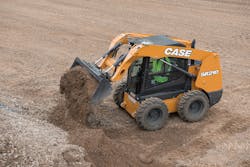Uptime Tips for Skid Steer Loaders
Machines can’t earn when they can’t work. That’s not only true for high-production machines such as larger excavators and wheel loaders, but also for compact iron such as skid steer loaders.
Debbie Townsley, product marketing manager for skid steers and CTLs at Case Construction Equipment, provides a good set of maintenance tips for skid steer owners.
“Ultimately, the overall health and longevity of a machine often comes down to daily and weekly maintenance procedures,” Townsley says. “The operator and other job site personnel are often the first line of defense against costly equipment downtime, so it’s critical for owners and operators to follow maintenance best practices.”
First, Townsley says, keep an eye on the tires.
“There are several basic maintenance items that can help fleet managers and equipment owners maximize tire life. First, keep them clean—hose off the tires and remove debris regularly. Check tread depth, and work with your dealer to determine when the tires need replaced. Check the tires and rims, looking for any cuts, cracks, abrasions, or uneven wear on the tires. Improperly inflated tires can cause unnecessary wear and damage and can wreak havoc on total cost of ownership, so tire pressure should be checked daily,” she says.
Irregular wear can be present for a variety of reasons, and Townsley recommends the best way to minimize it is to follow the manufacturer-recommended rotation intervals.
“Check the fluid levels for engine and hydraulic oil, diesel and DEF, and coolant,” she says. “Fluids are the lifeblood of each machine and require specified levels to operate properly. A sudden drop in fluid levels may point to any number of problems with the machine that require immediate attention, such as blown hoses or a leaking filter. Using OEM-spec engine oils helps to ensure that a machine will operate as efficiently as possible throughout its lifetime. It also ensures that the machine stays on the proper maintenance schedule that it was designed for.”
Filter maintenance is another key.
“Check the fuel, oil, air, and other filters for signs of damage or leaking,” Townsley says. “Filters are often a quick and easy item to replace, and operating with properly working filters can prevent any number of problems with the machine. The hydraulic system should also be inspected regularly to check for leaks or other potential issues.
“Check belts, such as the alternator belt and fan belt,” Townsley says. “A worn and frayed belt is another wear item that is relatively easy to replace. If noticed before it fails, then the operator can communicate with the maintenance team to replace it during scheduled downtime or the next PM to ensure it doesn’t create unplanned downtime.”
Townsley also stresses the importance of looking at the machine as a whole.
“Check regularly for any signs of structural damage, scratches or dents on the machine. This is almost more important post-operation than it is pre-operation,” she says.
“Once done for the day, noticing and identifying any damage to the machine ensures that needed repairs are made before the next shift starts, and also allows the operator to identify how that damage occurred,” Townsley says.
“Is there another structure on site that the machine came into contact with? Is there damage elsewhere on site that needs to be addressed? Similarly, if damage is noticed before a shift starts, and it was not there when the operator inspected it the day before, that pinpoints that something happened overnight or that there was possible unauthorized use of the machine,” she says.
